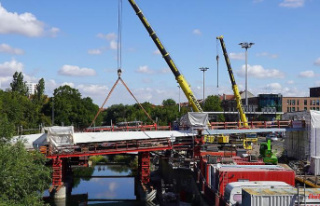It was the proverbial coincidence that led to one of the most spectacular finds of a shipwreck in northern Germany. During one of the regular measurements in the fairway of the Trave river in Lübeck in 2020, the Waterways and Shipping Authority located an unevenness eleven meters deep. In order to rule out any danger to shipping, an initial assessment of the find followed and there was a suspicion that it could be a sunken ship.
Divers finally examined the object more closely in August 2021, photographed the find and took samples. The results confirmed the assumption that it was a sunken ship - and not just any old one, but a very old one, a galliot or flute, as was common around 400 years ago.
On Tuesday, the Hanseatic City of Lübeck and the researchers involved presented details. The ship is around 20 meters long and eight meters wide and definitely comes from the Hanseatic period. Determining the age of the ship's timbers showed that the ship must have been built in the middle of the 17th century. It also still has more than 70 barrels of its cargo on board. The researchers were able to locate around 70 more barrels around the ship.
“One always hopes for such a find and suddenly it is in front of one. Being able to dive and explore such a well-preserved wreck is really unique,” said Fritz Jürgens from the Institute for Prehistory and Protohistory (UFG) at the University of Kiel.
According to initial findings, the ship must have been on its way from Scandinavia to Lübeck, where it never arrived. Initial indications indicate that the ship may have run aground at a bend in the Trave, was severely damaged there and therefore sank. There is a document in the Lübeck archives, after which the time of the accident could be dated to the year 1680. At that time, the Voigt of Travemünde, today a district of Lübeck, wrote about a ship that had sunk in the Trave and whose cargo had to be salvaged.
Wooden beams and large parts of the cargo are still left of the ship. They are covered with shells and, according to Jürgens, must have been lying in the murky waters of the Trave for centuries. The Institute for Geosciences at Christian-Albrechts-University (CAU) was able to identify the charge as lime. Apparently the ship transported burnt lime, a popular building material at the time. Mortar was made from it.
In a statement from the city administration, Lübeck's mayor Jan Lindenau spoke of a "sensational find" and announced that Lübeck would endeavor to preserve the cultural monument. Wreck finds are not uncommon in the Baltic Sea, but sunken ships are found much more frequently in the eastern part of the Baltic Sea than now far to the west.
The founding of the wreck and its cargo will include new aspects both for research and for the importance of the Hanseatic city of Lübeck across the entire Baltic Sea region, announced the Lübeck conservationists involved. Ulrich Müller, an archaeologist from the University of Kiel who was consulted, called the former Hanseatic ship an "archaeological jewel" whose salvage provided "fascinating insights into the history of seafaring and maritime trade".
The aim now is to salvage the wreck as quickly as possible, conserve it and then make it available for research and exhibition. The city of Lübeck announced that the salvage alone would take several months, and the subsequent conservation even years.












